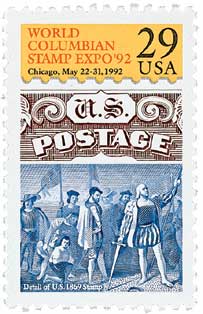
# 230-40 - 1893 Columbians, "short" set, 11 stamps
1893 Columbians
2¢ Landing of Columbus: This stamp shows Columbus coming ashore at Guanahani (San Salvador) in the West Indies. He claimed the land in the name of King Ferdinand and Queen Isabella of Spain. And so certain was Columbus that he was in India, he called the natives “Indians.” A popular error known as the “Broken Hat” variety occurred during the printing of this stamp – when a break developed in the printing press’s transfer roll. The flaw caused a piece to be missing from the hat of the foreground figure to the left of Columbus.
3¢ Flagship of Columbus: The Santa Maria was the flagship of Columbus. It was the largest vessel in his small fleet (measuring 117 feet in length as opposed to the 50-foot length of the Nina and the Pinta), and it was the one on which Columbus sailed.
4¢ Fleet of Columbus: Columbus set forth on his journey with three ships, and each one played a significant part in the story of Columbus’ discovery. It was from the Pinta that land was first sighted. While exploring the islands, the flagship Santa Maria was run aground in strong winds and was totally disabled. Forced to sail on the Nina, Columbus feared he would never make it back to Spain because of severe weather. He wrote down the story of his discovery and threw it over the side. He was determined that the world would know his story even if he died before reaching Spain.
15¢ Columbus Announcing His Discovery: When Columbus was summoned to Barcelona to tell the King and Queen what he had found during his voyage, they were impressed. They did not want Portugal to launch their own ships and discover lands that could belong to Spain. They immediately made plans to send Columbus on another voyage.
30¢ Columbus at La Rabida: In his search for a patron to finance his first voyage, Columbus went to La Rabida, where he met a ship owner named Martin Alonso Pinson. Pinson was very supportive of Columbus and his wish to sail west across the ocean. The two men became partners, and ultimately, Pinzon was the commander of the Pinta during Columbus’ maiden voyage.
50¢ Recall of Columbus: In the New World, Columbus was ruling with a harsh hand. Messengers returned to Spain to tell the king and queen of Columbus’ wicked ways. They immediately dispatched an employee of the throne to go to the New World and administer justice. Columbus refused to obey the court’s order, and he was recalled to Spain.
World’s Columbian Exposition
Though the 1876 world’s fair in Philadelphia had been a financial failure, American businessmen wanted to try again. Particularly, they wanted to hold a fair marking the 400th anniversary of Columbus’ landing in America. While several cities made a bid to host the expo, Chicago was ultimately selected when banker Lyman Gage raised several million dollars in a 24-hour period, putting him ahead of the competition.
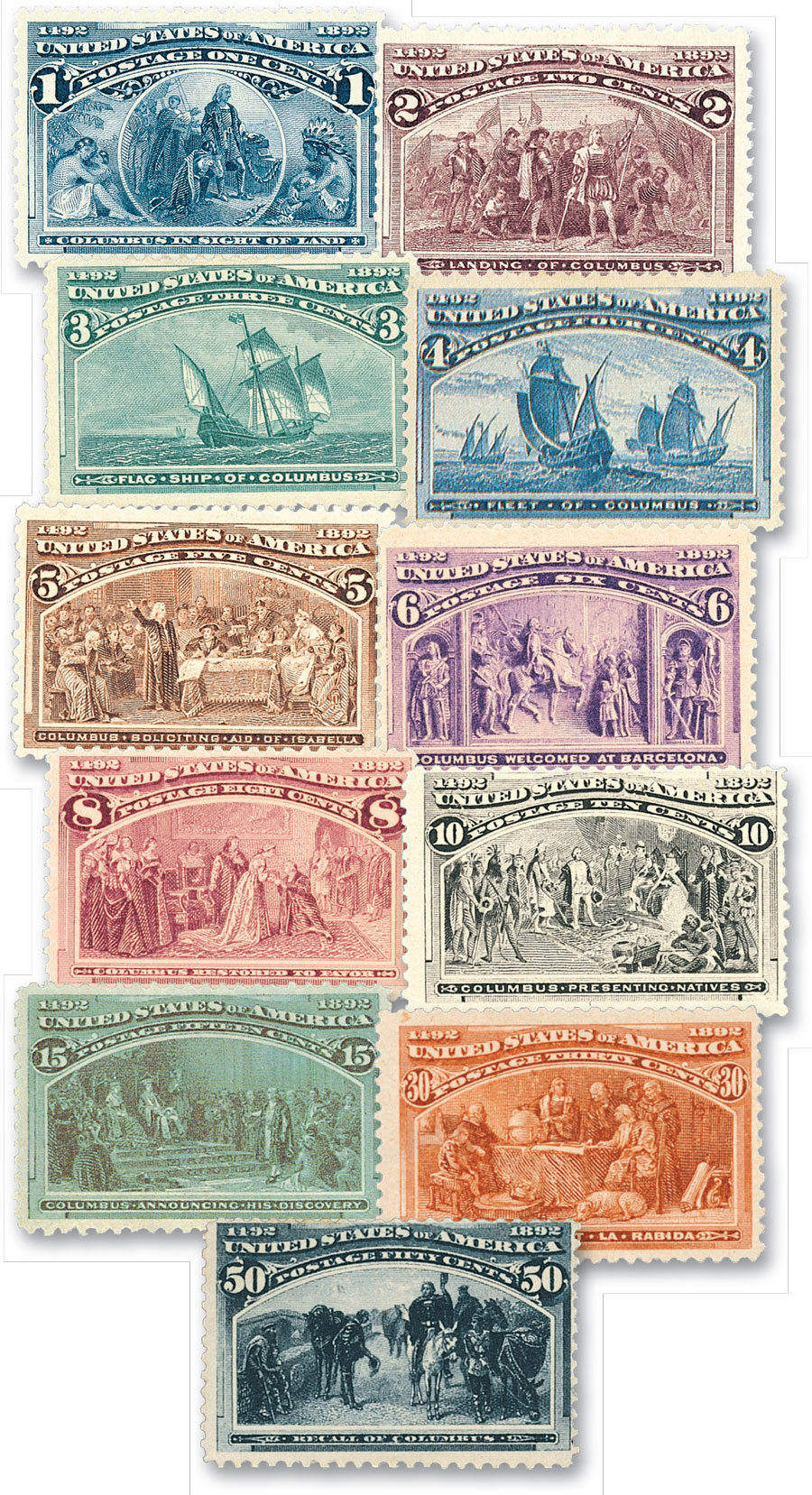
Work began immediately on preparing the exposition grounds. The exposition was supposed to open on October 21, 1892, but the grounds were so massive, that was impossible. Instead, the city of Chicago staged an extravagant three-day dedication celebration for October 20-22, which included a massive parade and series of ceremonies. The parade was held on October 20, 1892. It was both a celebration of the fair as well as Columbus’ arrival in America.
It was one of the largest single parades up to that time, with a large number of notable guests from a variety of different associations. Its been estimated there were at least 75,000 parade participants and over a million spectators from around the country. Click here to see photos of the parade and a long list of those involved in the procession.
October 21, 1892, was the official dedication day. It began with a sunrise salute by national guardsmen from all the states at the time, numbering about 10,000. President Benjamin Harrison and his cabinet were in attendance. They then joined in a 300-carriage procession through much of the exposition grounds to the Manufactures building. The dedication ceremony there included a number of speeches and presentations as well as performances of “The Star-Spangled Banner” and “Hail Columbia.” The celebrations continued into the night, with the archbishop of Ireland delivering a speech. The ceremonies concluded the next day with additional dedication ceremonies.
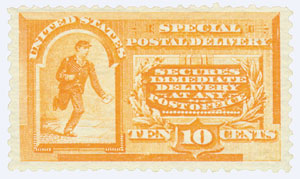
Work on the grounds continued after the dedication so that the exposition could open up on May 1, 1893. In an age before mass communication, the Columbian Exposition brought nearly 27 million people from around the world together to display the highest level of architecture, art, and industry. Hundreds of specially designed buildings, fountains, and statues were constructed specifically for the Exposition.
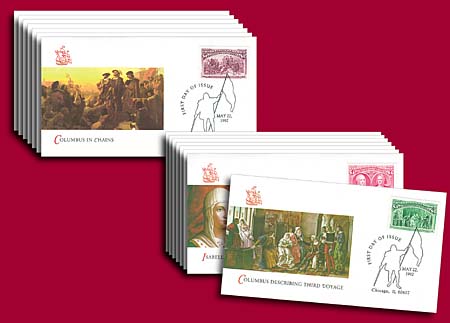
Spanning more than 600 acres, the Exposition featured over 200 buildings by top architects of the time. The classically styled buildings were all painted white, giving that section of the expo the name, “White City.” These spectacular buildings served as the inspiration for L. Frank Baum’s Emerald City in the Wizard of Oz as well as Walt Disney’s theme parks (his father was a construction worker at the Fair). In fact, the Fair’s architecture inspired the nationwide City Beautiful Movement, in which cities coordinated landscapes, promenades, and structures to make more stunning, cohesive urban areas.
With so many people from different places coming to one location, several congresses and parliaments were held to take advantage of the unprecedented gathering. There were congresses dealing with a number of topics including anthropology, labor, medicine, temperance, commerce and finance, literature, history, art, philosophy, and science.
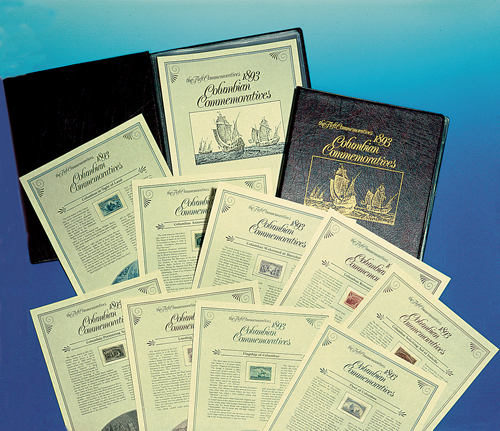
The largest of them all was the Parliament of Religions. Held from September 11 to 27, it marked the first meeting of representatives of Eastern and Western religions. Among the speeches given was one by Hindu representative Swami Vivekanand, “As the different streams having their sources in different places all mingle their water in the sea, so, O Lord, the different paths which men take, through different tendencies, various though they appear, crooked or straight, all lead to Thee!” This quote from the Bhagvad Gita seemed especially fitting for this significant convergence of religions.
The 1893 Exposition was also the first World’s Fair to include national pavilions. In all, 46 nations participated, introducing Americans to a wide array of new technologies and cultural traditions. These included German artillery and a Viking ship from Norway. W.C. Handy, Scott Joplin, and several others also introduced the world to the African-American musical style through performances.
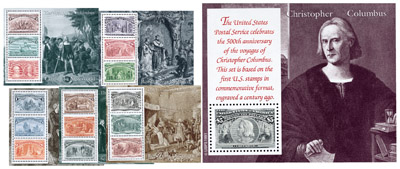
Other significant firsts at the Fair included the first US commemorative coins and the introduction of Cracker Jacks, Quaker Oats, and Shredded Wheat. The US Post Office Department also issued its first commemorative stamps ever, the highly sought-after Columbians.
Click here to view scenes from the Columbian Expo and here for more about the 1893 Columbians.
1893 Columbians
2¢ Landing of Columbus: This stamp shows Columbus coming ashore at Guanahani (San Salvador) in the West Indies. He claimed the land in the name of King Ferdinand and Queen Isabella of Spain. And so certain was Columbus that he was in India, he called the natives “Indians.” A popular error known as the “Broken Hat” variety occurred during the printing of this stamp – when a break developed in the printing press’s transfer roll. The flaw caused a piece to be missing from the hat of the foreground figure to the left of Columbus.
3¢ Flagship of Columbus: The Santa Maria was the flagship of Columbus. It was the largest vessel in his small fleet (measuring 117 feet in length as opposed to the 50-foot length of the Nina and the Pinta), and it was the one on which Columbus sailed.
4¢ Fleet of Columbus: Columbus set forth on his journey with three ships, and each one played a significant part in the story of Columbus’ discovery. It was from the Pinta that land was first sighted. While exploring the islands, the flagship Santa Maria was run aground in strong winds and was totally disabled. Forced to sail on the Nina, Columbus feared he would never make it back to Spain because of severe weather. He wrote down the story of his discovery and threw it over the side. He was determined that the world would know his story even if he died before reaching Spain.
15¢ Columbus Announcing His Discovery: When Columbus was summoned to Barcelona to tell the King and Queen what he had found during his voyage, they were impressed. They did not want Portugal to launch their own ships and discover lands that could belong to Spain. They immediately made plans to send Columbus on another voyage.
30¢ Columbus at La Rabida: In his search for a patron to finance his first voyage, Columbus went to La Rabida, where he met a ship owner named Martin Alonso Pinson. Pinson was very supportive of Columbus and his wish to sail west across the ocean. The two men became partners, and ultimately, Pinzon was the commander of the Pinta during Columbus’ maiden voyage.
50¢ Recall of Columbus: In the New World, Columbus was ruling with a harsh hand. Messengers returned to Spain to tell the king and queen of Columbus’ wicked ways. They immediately dispatched an employee of the throne to go to the New World and administer justice. Columbus refused to obey the court’s order, and he was recalled to Spain.
World’s Columbian Exposition
Though the 1876 world’s fair in Philadelphia had been a financial failure, American businessmen wanted to try again. Particularly, they wanted to hold a fair marking the 400th anniversary of Columbus’ landing in America. While several cities made a bid to host the expo, Chicago was ultimately selected when banker Lyman Gage raised several million dollars in a 24-hour period, putting him ahead of the competition.

Work began immediately on preparing the exposition grounds. The exposition was supposed to open on October 21, 1892, but the grounds were so massive, that was impossible. Instead, the city of Chicago staged an extravagant three-day dedication celebration for October 20-22, which included a massive parade and series of ceremonies. The parade was held on October 20, 1892. It was both a celebration of the fair as well as Columbus’ arrival in America.
It was one of the largest single parades up to that time, with a large number of notable guests from a variety of different associations. Its been estimated there were at least 75,000 parade participants and over a million spectators from around the country. Click here to see photos of the parade and a long list of those involved in the procession.
October 21, 1892, was the official dedication day. It began with a sunrise salute by national guardsmen from all the states at the time, numbering about 10,000. President Benjamin Harrison and his cabinet were in attendance. They then joined in a 300-carriage procession through much of the exposition grounds to the Manufactures building. The dedication ceremony there included a number of speeches and presentations as well as performances of “The Star-Spangled Banner” and “Hail Columbia.” The celebrations continued into the night, with the archbishop of Ireland delivering a speech. The ceremonies concluded the next day with additional dedication ceremonies.

Work on the grounds continued after the dedication so that the exposition could open up on May 1, 1893. In an age before mass communication, the Columbian Exposition brought nearly 27 million people from around the world together to display the highest level of architecture, art, and industry. Hundreds of specially designed buildings, fountains, and statues were constructed specifically for the Exposition.

Spanning more than 600 acres, the Exposition featured over 200 buildings by top architects of the time. The classically styled buildings were all painted white, giving that section of the expo the name, “White City.” These spectacular buildings served as the inspiration for L. Frank Baum’s Emerald City in the Wizard of Oz as well as Walt Disney’s theme parks (his father was a construction worker at the Fair). In fact, the Fair’s architecture inspired the nationwide City Beautiful Movement, in which cities coordinated landscapes, promenades, and structures to make more stunning, cohesive urban areas.
With so many people from different places coming to one location, several congresses and parliaments were held to take advantage of the unprecedented gathering. There were congresses dealing with a number of topics including anthropology, labor, medicine, temperance, commerce and finance, literature, history, art, philosophy, and science.

The largest of them all was the Parliament of Religions. Held from September 11 to 27, it marked the first meeting of representatives of Eastern and Western religions. Among the speeches given was one by Hindu representative Swami Vivekanand, “As the different streams having their sources in different places all mingle their water in the sea, so, O Lord, the different paths which men take, through different tendencies, various though they appear, crooked or straight, all lead to Thee!” This quote from the Bhagvad Gita seemed especially fitting for this significant convergence of religions.
The 1893 Exposition was also the first World’s Fair to include national pavilions. In all, 46 nations participated, introducing Americans to a wide array of new technologies and cultural traditions. These included German artillery and a Viking ship from Norway. W.C. Handy, Scott Joplin, and several others also introduced the world to the African-American musical style through performances.

Other significant firsts at the Fair included the first US commemorative coins and the introduction of Cracker Jacks, Quaker Oats, and Shredded Wheat. The US Post Office Department also issued its first commemorative stamps ever, the highly sought-after Columbians.
Click here to view scenes from the Columbian Expo and here for more about the 1893 Columbians.





